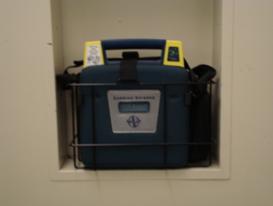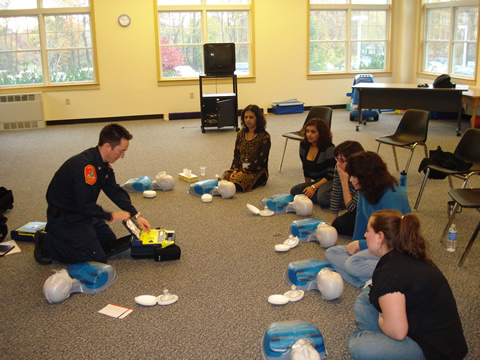AED
 Sudden cardiac arrest (SCA) can occur at all ages. The only treatment of SCA is defibrillation
such as that provided by an automated external defibrillator (AED). In the United
States more than 350,000 people die each year from SCA before reaching a hospital.
In many cases SCA can be reversed with early defibrillation. Defibrillation involves
shocking the heart with an electric current that allows the heart to reestablish its
normal rhythm. To be most effective, defibrillation must occur as soon as possible
after the onset of SCA. The chance of survival from sudden cardiac arrest decreases
by 7-10 percent per minute until defibrillation. AEDs have been shown to be easyto
use (by nonmedical personnel), are safe, and are effective in saving lives.
Sudden cardiac arrest (SCA) can occur at all ages. The only treatment of SCA is defibrillation
such as that provided by an automated external defibrillator (AED). In the United
States more than 350,000 people die each year from SCA before reaching a hospital.
In many cases SCA can be reversed with early defibrillation. Defibrillation involves
shocking the heart with an electric current that allows the heart to reestablish its
normal rhythm. To be most effective, defibrillation must occur as soon as possible
after the onset of SCA. The chance of survival from sudden cardiac arrest decreases
by 7-10 percent per minute until defibrillation. AEDs have been shown to be easyto
use (by nonmedical personnel), are safe, and are effective in saving lives.
The Department of Environmental Health & Safety is responsible for coordinating and implementing the Universitiy's AED Progam. The program was developed as a result of the NYS Office of General Services (OGS) promulgation of regulations requiring all NYS owned/operated public buildings to be equipped with on-site cardiac automated external defibrillators (AED'S).
What is an AED?
A semi-Automatic External Defibrillator, AED for short, is a small portable device that analyzes the heart rhythm of a person who is in cardiac arrest. It determines if the person is in a rhythm called Ventricular Fibrillation (VF). If the person is in VF, the AED will deliver a series of shocks that, depending on the circumstances, could convert the person's heart rhythm back to the normal rhythm and greatly increase their chance of survival.
The goal, with the placement of AEDs in public places, is to have the unit applied and a shock delivered within three minutes. This statistic increases the chance that a cardiac arrest victim will walk out of the hospital from ten percent or less to sixty to seventy percent. An ambulance, even in the best system, might take upwards of ten minutes to arrive even if someone immediately calls 911.
The Powerheart G3 Defibrillator that is installed around campus, in the University Police Vehicles and Fire Marshal Vehicles.

AEDs that are installed around campus are mounted in conspicuous locations in a white case. The cases are alarmed.

Automatic External Defibrillator Training
Several hundred employees, including Universitiy Fire Marshals, Police Officers, Athletic coaches and trainers, and other staff have completed the training and are CPR/AED certified. AED training is now a component of all CPR and First Aid classes taught on campus. AED training is required for anyone who plans to use the AED. Recertification is recommended every two years. To schedule a training session contact your building Manager or the Fire Marshals office at 632-9678.
Unlike manual defibrillators used in hospitals and by paramedics, the AEDs that are installed throughout the campus are extremely easy to operate. The devices use clear graphical and spoken instructions. The AEDs analyze the victim's condition and, only if warranted, deliver an electric shock to the heart to reverse SCA. The devices are extremely safe with no risk of inappropriate shock given to individuals who are not in SCA or to the person operating the AED.
However, you do not need to be certified to use an AED: if you choose to assist someone you believe is in need of an AED, you will be covered under the Good Samaritan law. However, CPR certification can be very important to know when using an AED. If the AED delivers an electric shock, the device will then prompt you to administer CPR. Additionally, emergency medical personnel may not be able to arrive before the device prompts you to administer CPR.
Although training is required for a person who operates an AED as part of or incidental to his or her employment or regular duties, the lack of training shall not prohibit others from using an AED, as long as they are acting in good faith, with reasonable care, and without expectation of monetary compensation. More information about the NYS Good Samaritan law can be found in NYS Public Health Law Article 30.

For more information, please call the Fire Marshals office at (631) 632-9678.
AED Locations
AED's are installed in wall-mounted cabinets or on hangers throughout campus. Each cabinet is equipped with a high-pitched local alarm that sounds when the cabinet door is opened and is silenced upon securely closing the door.
In addition, AED's are carried on University emergency vehicles, including Fire Marshals, Police Officers and the Stony Brook Volunteer Ambulance Corp.
To view a list of locations where AED's are installed click here. Please note that this list is under construction as we are currently updating our locations.
